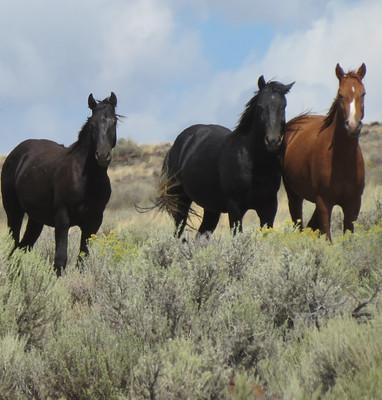BLM plans gather of excess wild horses: October gather will take place in Twin Peaks Herd Management Area
SUSANVILLE, Calif. – The Bureau of Land Management has announced plans to gather and remove excess wild horses from public rangelands in the Twin Peaks Herd Management Area to prevent impacts to rangeland health in Lassen County, Calif., and Washoe County, Nev. Gather operations will begin Tuesday, Oct. 1, and could continue for 15 days or longer.
The BLM plans to gather about 940 wild horses and remove about 870 of those from the rangeland along the California-Nevada border northeast of Susanville. Animals removed will be prepared for placement in private ownership through adoption or sale. Some animals, including mares treated with fertility control, would be returned to the range to maintain herd viability.
Operations will focus on wild horse home ranges in the northern and southern areas of the Twin Peaks HMA. In addition to managing populations within the herd management area, the operation will remove horses that are roaming outside of the HMA boundaries.
“While our gather in 2022 reduced populations, additional removals are needed to bring the population down to the appropriate management level of 448 to 758 wild horses,” said BLM Eagle Lake Field Manager Emily Ryan. “These high populations are causing rangeland degradation in the herd management area, with wild horses using more than their allocated forage and damaging riparian areas, wetlands and cultural resource sites.
Members of the public will be welcome to observe gather operations each day. They must reserve space by calling the gather information line at 530-252-5332 at least a day before they plan to visit. Information on the meeting location and time will be provided on the information line. Observation groups will be limited to 10 persons per day due to limited space for people and vehicles.
Those who plan to visit should plan on spending the entire day at the observation site. There are no nearby services and there will be no cell coverage. Temperatures this time of year may be cold when operations begin at dawn, warming to the 60s and low 70s in the afternoons.
Based on aerial counts earlier this summer and subsequent population modeling, the BLM believes there are about 1,800 wild horses and 140 wild burros in the herd management area that encompasses more than 800,000 acres including approximately 656,000 acres of BLM-managed public land.
The decision to gather excess animals was analyzed in a 2019 environmental assessment covering a 10-year period. The Notice of Decision authorizing the upcoming gather, the 2019 EA, and a determination of adequacy under the National Environmental Policy Act are available online.
The BLM is responsible under the Wild Free-Roaming Horses and Burros Act for protecting and managing wild horses and burros to protect resources and ensure healthy herds. The agency periodically removes animals from the range when populations exceed levels established to allow the herds to thrive in balance with other users including wildlife and permitted livestock. More information about the BLM’s Wild Horse and Burro Program is available online.
The BLM manages more than 245 million acres of public land located primarily in 12 western states, including Alaska, on behalf of the American people. The BLM also administers 700 million acres of sub-surface mineral estate throughout the nation. Our mission is to sustain the health, diversity, and productivity of America’s public lands for the use and enjoyment of present and future generations.

